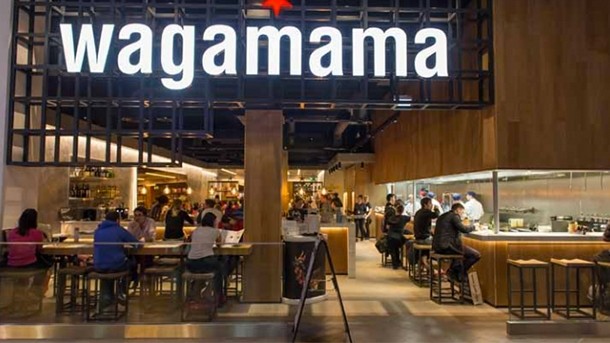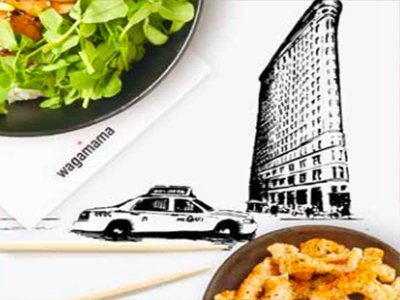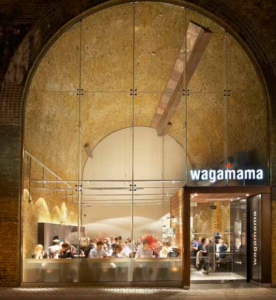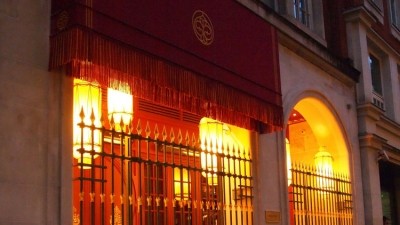The Way of the Noodle: How Wagamama is going global

It will be three years this September since David Campbell took over as chief executive of Wagamama. For him, his time in charge of the well known noodle chain famously founded by Alan Yau has felt “like a long time, but also a short time” when considering the job he initially faced.
A relative unknown inside the sector, the former head of London’s O2 Arena and the man once tipped to succeed Bernie Ecclestone as the head of Formula One motor racing, took on the top job at Wagamama after the role was left vacant by the sudden departure of Steve Easterbrook in April 2013. Easterbrook, best known for his time at McDonald’s (he is now its CEO), had spent less than a year in the job, following a similarly short stint as chief executive of PizzaExpress, before returning to McDonald’s and, in time, to its top role.
Campbell is a veteran of the entertainment industry and had helped turn the O2 Arena, the former Millennium Dome in Greenwich, into the world’s most popular music venue. Before that, he worked for Sir Richard Branson’s Virgin Group for 11 years, rising to become boss of Virgin Radio and masterminding the sale of the station to Scottish broadcaster SMG for £225m.
Noodles, therefore, might not necessarily seem Campbell’s forte, yet his experience with dealing with and turning around struggling brands (it’s hard to believe the O2 Arena was once considered a white elephant) has given him the required skill set to pull Wagamama out of the state of flux it had found itself in following its acquisition by private equity firm Duke Street Capital in 2011.
The business, through the departure of long-standing chief executive Steve Hill just over a year after completion of the deal, coupled with Easterbrook’s short stay at the helm, was in trouble of drifting to the edges of the sector. One of the ‘Champions League’ casual-dining brands in the UK was threatened with a drop to the ‘Europa League’.
Putting food at the forefront
Before he took on the role, Campbell made sure he had done his research into the brand that, at one time, was one of the most respected restaurant chains in the UK. Launched in 1992 in London by Yau, Wagamama was a pioneer in many aspects of the restaurant sector thanks to its cutting-edge minimalist design, comparatively healthy food, communal dining, low prices, dishes turning up at different times and no-smoking policy. It repackaged ethnic food in a way that no brand had achieved, making Japanese food both cool and accessible and achieved strong growth in the early years after being taken on by venture capitalists. However, by 2011 the company had begun to lose its way as more fleet-of-foot ethnic operators gained ground.
Campbell’s research included reading a copy of Way of The Noodle, the book that sets out the kaizen philosophy of the Wagamama brand – inspired by fast-paced, Japanese ramen bars – that Yau helped to write. “My take was ‘that’s the bible, that’s the playbook’, let’s go for it,” says Campbell. “It was also nice someone had written the plan for me. It was probably too focused in the kitchens and not focused in the front of the restaurant and telling people about what it did. We were running, but not hard enough or in the right directions.”
To change that, Campbell invested in a massive market research campaign, interviewing 5,000 customers in the UK and US. “It’s what drove us,” he says.
Changes were made on the back of what his research uncovered, including making much more of a feature of the kitchens. The most extreme version of this is at its Uxbridge site, where the kitchen is located in the front window of the restaurant so passers-by can see the chefs in action. This has since become a blueprint for all new openings. “Now any new restaurant we build, you go past the kitchen the minute you walk in the door. That’s really important, because people see the food being prepared in front of them. For Millennials, or whatever you want to call that generation of people today, that is far more important than it ever was before.”
The company initially intended to carry out 20 refurbs this year to change the layout, but Campbell now thinks this figure will be more than 30.
International expansion
Another area that Campbell has rejuvenated has been Wagamama’s plans for international expansion. In the past the company had recognised its potential across the pond, with Hill saying in 2010 that there was scope for 650 managed sites in the US, including 40 in Boston alone.
Yet this bold stance never truly came to fruition under the old management. While still impressive – Wagamama has three restaurants in the US, in or close to Boston, as well as further ones in Bahrain, Qatar, Belgium and other European countries – the company’s international presence has so far failed to live up to its high expectations.
With Campbell, however, there are the signs that it will become a true global brand by the end of this decade. He has already taken significant steps to make that a reality over the past few months, signing deals to launch in France, Italy, Portugal and Spain.
In terms of the company’s international franchise operation, Campbell believes it had been more “receptive than proactive” in the past, but that this had changed since the appointment of Brian Johnston as international managing director two years ago. The group, which currently operates 35 restaurants internationally, has signed a multi-restaurant agreement with Cases Loisirs-owned company W Restaurants France to launch across the Channel, with a first site contracted to open in Paris before the end of the year and another in the first quarter of next year. The contract stipulates that the first two years will be focused on opening sites in the greater Paris area, before the brand looks at expanding into other French cities.
In addition, Wagamama will make its debut in Madrid early next year, with more restaurants across Spain and also Portugal to follow after agreeing a multi-restaurant franchise deal with Grupo Vips, one of Spain’s leading multi-brand restaurant and retail groups.
At the same time, it is set to open its first site in Jeddah in Saudi Arabia later this year, with a further two openings in the country in the pipeline.
Perhaps most telling is the noodle chain’s increased presence on the hallowed restaurant ground that is the US, with two sites soon to open in New York. These restaurants in particular are a strong display of Wagamama’s intention to take on America properly. The first, in the Flatiron/Nomad area, is in a prominent position overlooking Madison Square Park, while the second will be located in Manhattan’s East Village. There will be little danger of New Yorkers failing to notice its presence in the city.
Campbell believes there is a “significant opportunity” in the US for the business and that it could expand quickly once it has achieved scale in New York and Boston. “We are seen as a young, trendy brand in the States, whereas here people don’t write about us at all or view us in the same way. I spoke to the guys at Shake Shack about this and for them it’s the flip side of that. They are seen as a cool, young brand here but not any more in the US, where they are seen as a chain.”
Evolution of the brand
To achieve its goal of becoming a truly international brand, Campbell has added more experience to and restructured the group’s management team, including moving Jane Holbrook from chief financial officer to chief operating officer; operations director Sarah Hills becoming UK managing director; Julia Rosamond moving from Travelodge to become the group’s people director; and Steven Boyce becoming property director. The company has also promoted Adam Gregory from regional director to managing director of North America.
Further growth in the UK is also a priority, and Campbell believes it will remain the bedrock of the brand’s success for the time being, yet he is coy about how big the brand can become over here. “I don’t think we’ll get to the scale of PizzaExpress or Nando’s, but we’ve definitely got room to grow in the UK.
“Starting as an urban brand and going into New York got us thinking about London a bit more. It started in London, but it really hadn’t opened that many restaurants there. As leases come up, we’ll get out of basement [locations] and out of slightly more obscure places and come above ground and recreate the brand as it is today within London.”
The group hopes to have exited from its last basement sites in the capital by the end of this year. It has also continued to build its estate in central London with a number of significant additions. Since the turn of the year, it has secured new sites for high-profile London openings in Soho’s Dean Street and at the Blue Fin building that sits directly behind Tate Modern. More recently, it secured the Hush brasserie site in St Paul’s from Jamie Barber for an opening later this year, and it is also believed to be close to signing on a site in Covent Garden.
“In terms of the executive team, I want people who know what they are doing,” is his bullish approach. “It’s not a place for learning. We know you are good, that’s why you are here. Now get on with it.”
The proof of Campbell and his team’s work was seen last month, with full-year like-for-likes up 13.1 per cent, including a 16.2 per cent rise in its fourth quarter.
Not that Campbell will allow his team to take its eye off the ball. The company is soon to launch its own loyalty app to improve its approach to customer engagement and give it a better understanding of its customers’ behaviour to help it develop new business and marketing strategies in the future.
And then there’s his choice of location for the group’s new head office, in Soho’s Wardour Street, home to the second Wagamama restaurant. “We could have moved out to the sticks, but I wanted the team to be in the thick of the action,” he says.
“Every other week there is someone opening and closing here. Every time they leave the front door they can see the competition we are up against, the new openings and concepts.”



















